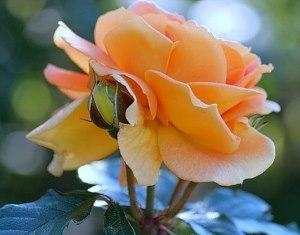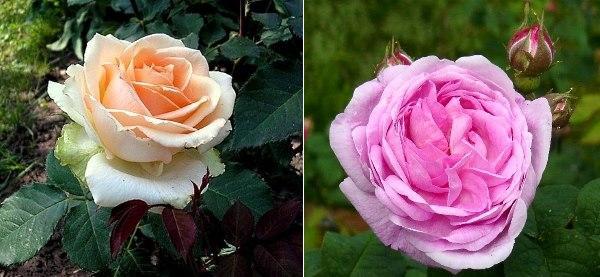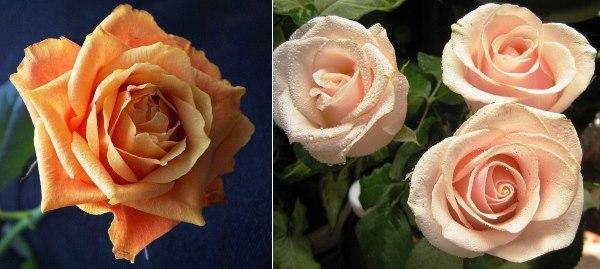Tea rose - fragrant beauty in the garden and at home
 An aristocratic beautiful tea rose (see photo) with an exquisite aroma, delicate flowers of delicate shades can decorate any summer cottage and city lawn. It is not only pleasing to the eye, but also has unique healing qualities. Therefore, growing a tea rose is extremely rewarding and useful.
An aristocratic beautiful tea rose (see photo) with an exquisite aroma, delicate flowers of delicate shades can decorate any summer cottage and city lawn. It is not only pleasing to the eye, but also has unique healing qualities. Therefore, growing a tea rose is extremely rewarding and useful.
The history of the origin of the tea rose
Tea rose, it is also fragrant named so for its amazing fragrance, which smells like the best varieties of Chinese tea. Europe learned about the existence of this plant in the 19th century. The yellow rose was brought from China in 1824, and the pink rose a little later, in 1860, came to England from the East Indies. Thanks to the work of breeders, from two varieties crossed with hybrids of the French rose, a whole class of modern hybrid tea roses went, including bush varieties and whip-like - clays.
According to another version, the rose was called a teahouse due to the fact that delicate plants arrived from Asia on high-speed vessels, the so-called tea clippers, which were usually engaged in transporting tea.
One way or another, the first tea roses were afraid of any discomfort, were not adapted to the weather conditions of Europe. Gradually, they underwent acclimatization and cultivation, became more hardy and diverse. Today, most of the remontant roses (long-term and re-blooming), one way or another, are associated with tea in origin.

Botanical description of the tea rose
- They are distinguished by graceful thin, but strong stems and relatively large double flowers, single or collected in bouquets of up to 6 pieces.
- The dimensions of the bushes depend on the specific variety and growing conditions. Height ranges from 50 cm (low-growing varieties) to two meters and even higher (whip-like), spreading - from one meter to two in width.
- Large leathery dark green leaves have a regular oval shape with finely toothed edges.
- Each bud has up to 60 petals. When opened, the diameter of a flower can reach 10 cm, its shape is elongated-pointed or similar to pion ... The color range of shades is very wide and ranges from white and pale cream to red and fiery orange. Different shades of pink are still considered classic. When the petals are fully open, bright yellow stamens can be found in the middle.

Features of the modern hybrid tea rose
- There are many varieties that are resistant to disease and weather conditions that do not require careful maintenance. Nevertheless, the plant continues to be thermophilic, does not tolerate frost and is not suitable for growing outdoors in central Russia.
- The winter forcing of tea roses in greenhouses and greenhouses is practiced, as well as the maintenance of their undersized varieties in indoor conditions.
- In the flowering state, it spreads a sweetish rich odor, strong but not aggressive. The expressiveness of the aroma depends on the color of the buds: the brighter the color, the more intense the smell.
- It has many useful and medicinal properties. The petals contain vitamins, essential oils, pectin, organic acids, antiseptic substances. The taste is bittersweet. They are used to prepare medicinal tea, decoctions and lotions, jelly, jam and wine, grind with sugar or honey.
Agrotechnics
With proper care of the tea rose, it will thank the owner with long flowering.

Garden version of the tea rose
- Recommended for cultivation is soil saturated with iron, with a low level of acidity.
- Depending on the climatic conditions in the spring, usually in mid-May, the winter protection is removed from the bushes or they are transplanted from the pots into the ground. Mulching is encouraged.
- It is recommended to form a plant in order to direct all its forces to the development of peduncles. Shrubs are cleaned of dry stems and healthy branches are trimmed about three-quarters at a 45 ° angle. Flowering will begin in about a month.
- Rose loves regular abundant watering, without which the root system does not develop well. Watering at least once a week, you need to make sure that water does not fall on the leaves so as not to provoke diseases.
- To prevent powerful flowering from depleting the plant, it needs a liquid fertilizing every two weeks, which should be stopped a month before the expected frost. Using table salt will help brighten the color of the flowers.
- Afraid of powdery mildew. For prophylaxis - spray with nettle infusion or broth of wild horseradish.
Indoor version of the tea rose
- Although the plant loves warmth and sunlight, at home growing a tea rose on a south-facing window is not recommended: the buds will fade in the bud, and the rose itself (especially a young one) may die due to overheating. The rose feels best on the eastern window sill.
- In the summer, in hot weather, you need to water the rose daily, and in the cold season - every other day or once every two days, preventing the earth from drying out. Feed with liquid fertilizers.
I have such a tea beauty, I made friends with her easily, every day I water a little bit and put in the fertilizer stick for roses - that's all! Sits in the universal soil terra vita or living earth - in Russian